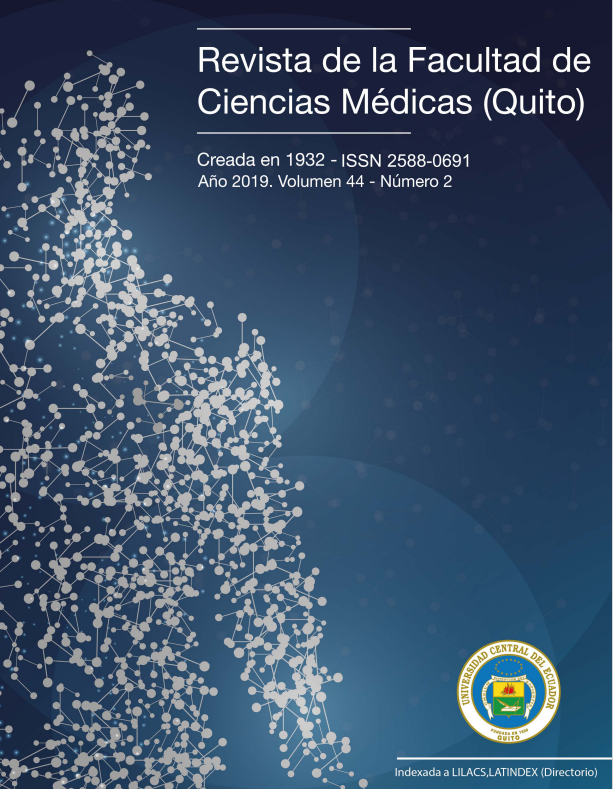Breast biomarkers in metastatic processes in Ecuadorian women
DOI:
https://doi.org/10.29166/rfcmq.v44i2.2688Keywords:
Metastatic breast cancer, carcinoembryonic antigen, cancer antigen 15-3Abstract
Background: CA 15-3 and CEA tumor markers are metastasis predictors in breast cancer; however, criteria of the advantages in determining them in an individual or joint way are still not consensual. Objective: To evaluate the association of CA 15-3 and CEA tumor markers, in individual or joint way, in Ecuadorian patients diagnosed with metastatic breast cancer. Methods: A prevalence study was carried out, based on the information obtained from the medical records of 90 women with breast cancer. The markers CA 15-3, CEA were identified individually and together (CA 15-3 - CEA) and the association between the presence or absence of metastasis was established by using Fisher's exact test and Cohen's Kappa index. In addition, the sensitivity, specificity, positive and negative predictive values of each tumor marker as individual element and as a whole were determined Results: The prevalence of invasive ductal carcinoma in locally advanced stages from IIB to IIIC was 77.8%. The bone and lung system were frequent sites of cancer spread. There was a statistically significant relation (p<0.05) between the individual or whole biomarkers values and the presence of metastatic processes, being CA 15-3 and CA 15-3-CEA the ones with the highest concordance. CA 15-3 presented 55% sensitivity and 91% specificity. CEA presented 30% sensitivity and 96% specificity. As a whole, those have 40% sensitivity and 100% specificity. Conclusions: A higher tumor burden and metastatic development correlate with CA15-3-CEA biomarker positivity as a set, reinforcing the clinical benefit of evaluating both biomarkers simultaneously.
Downloads
Metrics
References
Organización Mundial de la Salud. Cáncer [Internet]. 2018 [Consultado 12 oct 2018; citado 9 ene 2019]. Disponible en: https://www.who.int/es/news-room/fact-sheets/detail/cancer
Dornelles CM, Santos P, Oliveira CB, Goldim JR, Prolla PA. Conocimiento del cáncer de mama y cáncer de mama hereditario en el personal de enfermería de un hospital público. Rev. Latino-Am. Enfermagem. 2015;23(1):90-97.
Ministerio de Salud Pública. Ministerio de Salud comprometido en la lucha contra el cáncer de mama [Internet]. [Consultado 9 Oct 2018]. Disponible en: https://www.salud.gob.ec/el-ministerio-de-salud-comprometido-en-la-lucha-contra-el-cáncer-de-mama/
Organización Mundial de la Salud. Perfiles Oncológicos de los países [Internet]. World Health Organization; 2014 [Consultado 26 Nov 2018]. Disponible en: https://www.who.int/cancer/country-profiles/es/#E
Kabel, AM. Tumor markers of breast cancer: New prospectives. Journal of Oncological Sciences. 2017;3(1):5-11.
Reyes Garcia N, Miranda-Dévora G. Marcadores tumorales en cáncer de mama: CA 15-3 y antígeno carcinoembrionario. Rev Mex Mastol. 2016;6(1):9-13.
Wu S, He Z, Zhou J, Sun J, Li F, Lin Q, et al. Serum levels of CEA and CA15-3 in different molecular subtypes and prognostic value in Chinese breast cancer. Breast Edinb Scotl. 2014;23(1):88-93.
European group on tumor markers. Recomendaciones del grupo europeo sobre marcadores tumorales. [Consultado 25 Nov 2018; citado 15 oct 2019]. Disponible en: https://www.egtm.eu/about-tumormarkers/breast-cancer#_ednref
Geng B, Liang M, Ye X, Zhao W. Association of CA15-3 and CEA with clinicopathological parameters in patients with metastatic breast cancer. Mol Clin Oncol. 2015;3(1):232-236.
González M, Bermejo A, Minguillón A, Sanz M, Utrillas AC, Rebollo FJ, et al. ¿Resultan útiles los marcadores tumorales CEA y CA 15-3 en el seguimiento del cáncer de mama? Revisión de 196 casos. Cir Esp. 2003;74(3):139-43.
Johnson G, Valdés Y, Polo J, Marcel E. Evaluación del marcador tumoral CEA y el CA 15-3 en pacientes con cáncer de mama. Rev Latinoam Patol Clin Med Lab. 2015;62(2):127-132.
Brusint B, Vich P, Álvarez-Hernández C, Cuadrado-Rouco C, Diaz-García N, Redondo-Mar-güello E, et al. Actualización del cáncer de mama en atención primaria (II/V). Semergen. 2014;40(7):3 81-391.
Bland KI, Copeland EM. La mama: manejo multidisciplinario de las enfermedades benignas y malignas. Vol. 1. 3a ed. España: Ed. Médica Panamericana; 2007.
American Joint Committee on Cancer. Cancer Staging Manual. 7a ed. New York: Springer; 2010.
Argimon J, Jiménez J. Métodos de investigación clínica y epidemiológica. 5ª ed. España: Elsevier; 2019.
Martínez P, Burruchaga H, Abeszyc D, Forno M, De la Roza L, Arias S. Cáncer de mama localmente avanzado. Rev Arg Mastol. 2014;33(118):28-38.
Dávila C. Cáncer de mama y metástasis óseas [Tesis Doctoral]. España: Universidad de Granada; 2013.
Maffuz-Aziz A, Labastida-Almendaro S, Sherwell-Cabello S, Ruvalcaba-Limón E, Domínguez-Reyes CA, Tenorio-Torres JA, Rodríguez-Cuevas S. Supervivencia de pacientes con cáncer de mama. Análisis por factores pronósticos, clínicos y patológicos. Ginecol Obstet Mex. 2016;84(8):498-506.
al-Jarallah MA, Behbehani AE, el-Nass SA, Temim L, Ebraheem AK, Ali MA, et al. Serum CA-15.3 and CEA patterns in postsurgical follow-up, and in monitoring clinical course of metastatic cancer in patients with breast carcinoma. Eur J Surg Oncol. 1993;19:74-79.
Lee J, Park S, Park J, Cho J, Kin S, Park B. Elevated levels of serum tumor markers CA 15-3 and CEA are prognostic factors for diagnosis of metastatic breast cancers. Breast Cancer Res Treat. 2013;141(3):477-84.
Yerushalmi R, Tyldesley S, Kennecke H, Speers C, Woods R, Knight B, et al. Tumor markers in metastatic breast cancer subtypes: frequency of elevation and correlation with outcome. Ann Oncol. 2012;23:338-345.
Pedersen A, Sorensen P, Jacobsen E, Madsen J, Brandslund I. Sensitivity of CA 15-3, CEA and serum HER2 in the early detection of recurrence of breast cancer. Clin Chem Lab Med. 2013;51(7):1511-1519.
Ocaña E, Aceituno I. Utilidad clínica de los marcadores tumorales. Rev Med Jaen. 2014;4:1-9.
Saldivia F, Ramos S, Baez E, Gutierrez N, Miranda J, López J, et al. Valor predictivo del Ca 15-3 como marcador tumoral en cáncer de mama. Rev Venez Oncol. 2006;18(2):92-97.
Yang Y, Zhang H, Zhang M, Meng Q, Cai L, Zhang Q. Elevation of serum CEA and CA15-3 levels during antitumor therapy predicts poor therapeutic response in advanced breast cancer patients. Oncology Letters. 2017;14: 7549-7556.
Downloads
Published
Versions
- 2020-11-18 (2)
- 2019-12-11 (1)
How to Cite
Issue
Section
License
Copyright (c) 2020 Daysi A Morales1, Inés C Echeverría

This work is licensed under a Creative Commons Attribution-NonCommercial-NoDerivatives 4.0 International License.











